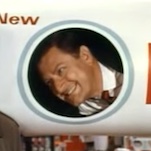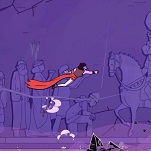Pretty much all of the animators interviewed for the piece stated that they were fans of Lord’s work, and the film overall. But there was also a repeated refrain that the Clone High co-creator’s preference for making editing decisions on the basis of completed footage—including making writing and story changes after seeing how a finished sequence played out, as opposed to working from less fully finished version of shots—created large amounts of additional work for people far beneath him in the animation pipeline. “These are a lot of artists affected by one change,” one artist, credited as “Stephen” in the piece, told Vulture. “Imagine an endless stream of them.” (Issues were exacerbated by the fact that hiring in animation often relies on having completed shots from a film to use in your portfolio, which obviously becomes difficult when completed work is being discarded from the final film.)
Multiple animators also said Spider-Verse had a bottleneck in its early production, as Lord worked with the film’s directors on its layouts—leaving numerous artists hired for the project idle, and watching with trepidation as the film’s deadlines, and the attendant deluge of work once production actually began, moved closer. (One source said that at least at one point, once production began in earnest, artists were working 11 hour days, 7 days a week on the film.) Ultimately, the sources quoted in the piece said that roughly 100 animators departed Spider-Verse, out of the 1,000 or so that Sony has said it hired for the film.
As for the film’s other producers, they’ve pushed back on many of the assertions in the article, with prolific Spider-Man film producer Amy Pascal stating that “One of the things about animation that makes it such a wonderful thing to work on is that you get to keep going until the story is right.” Admitting that the film faced several pretty drastic overhauls across its production, Pascal said, “If the story isn’t right, you have to keep going until it is.” (She was also somewhat bluntly unsympathetic to animators unhappy with having hours upon hours of creative work thrown out, saying, “I guess, welcome to making a movie.”) Meanwhile, Michelle Grady, from production house Sony Pictures Imageworks, denied that Lord was specifically responsible for any delays in the film, calling him, in Vulture’s words, “a convenient target for worker ire,” and saying that the sources who spoke for the report weren’t representative of the overall workforce on the film.
The real question in all this, of course, is what it might mean for the future, both for the Spider-Verse movies—another of which is supposedly due out next year—and animation in general, which has only become more and more resource-intensive in the digital era. Interestingly, most of the figures involved pretty much grant that the “try something, toss it out, try again” method attributed to Lord made for a better movie, with the basic point of contention boiling down to whether that method makes for reasonable labor practices for the people impacted by the need for more and more time-intensive animation work in order to fuel it—something that the the Animation Guild and other labor advocates will likely continue to push back on for years to come as they attempt to eke out reasonable business practices from the industry.








































